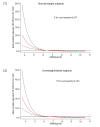Low appendicular skeletal muscle index increases the risk of carotid artery plaque in postmenopausal women with and without hypertension/hyperglycemia: a retrospective study
- PMID: 37340377
- PMCID: PMC10283215
- DOI: 10.1186/s12877-023-04076-w
Low appendicular skeletal muscle index increases the risk of carotid artery plaque in postmenopausal women with and without hypertension/hyperglycemia: a retrospective study
Abstract
Background: This study aimed to evaluate whether the low appendicular skeletal muscle index (ASMI) is closely associated with the risk of carotid artery plaque (CAP) in postmenopausal women with and without hypertension/hyperglycemia stratified by body mass index (BMI) categories.
Methods: A total of 2048 Chinese postmenopausal women aged 40-88 years were eventually enrolled in this retrospective study. Skeletal muscle mass was estimated by using segmental multifrequency bioelectrical impedance analysis. ASMI was defined as follows: appendicular skeletal muscle mass(kg)/[height(m)]2. CAP was assessed by B-mode ultrasound. We explored the association between ASMI quartiles or low skeletal muscle mass and the risk of CAP by using multivariate-adjusted logistic regression models. A potential nonlinear relationship was also tested using restricted cubic spline regression.
Results: CAP was observed in 289/1074 (26.9%) normal-weight and 319/974 (32.8%) overweight/obese postmenopausal women. Individuals with CAP had significantly lower ASMI values than those without (P < 0.001). The ASMI value also showed a linear relationship with the CAP risk in postmenopausal women stratified by BMI category (Pfor non-linearity > 0.05). In comparison with the highest ASMI quartile, the lowest ASMI quartile was significantly associated with a high risk of CAP development in non-hypertensive individuals with normal weight (odds ratio [OR] = 2.43; 95% confidence interval [CI]: 1.44 ~ 4.12) or overweight/obesity (OR = 4.82, 95% CI: 2.79 ~ 8.33), hypertensive individuals with normal weight (OR = 5.90, 95% CI: 1.46 ~ 11.49) or overweight/obesity (OR = 7.63, 95% CI: 1.62 ~ 35.86), non-hyperglycemic individuals with normal weight (OR = 2.61, 95% CI: 1.54 ~ 4.43) or overweight/obesity (OR = 2.94, 95% CI: 1.84 ~ 4.70), and hyperglycemic individuals with normal weight (OR = 6.66, 95% CI: 1.08 ~ 41.10) or overweight/obesity (OR = 8.11, 95% CI: 2.69 ~ 24.49). Moreover, low skeletal muscle was independently associated with the risk of CAP in postmenopausal women, regardless of the BMI category.
Conclusion: ASMI was inversely associated with the risk of CAP development in postmenopausal women, especially in patients with high blood sugar and/or hypertension, indicating that skeletal muscle mass maintenance may contribute to prevention of CAP in postmenopausal women.
Keywords: Appendicular skeletal muscle index; Carotid artery plaque; Hyperglycemia; Hypertension; Postmenopausal women.
© 2023. The Author(s).
Conflict of interest statement
The authors declare no potential competing interests.
Figures





Similar articles
-
The Prevalence Rate of Adult Sarcopenic Obesity and Correlation of Appendicular Skeletal Muscle Mass Index with Body Mass Index, Percent Body Fat, Waist-Hip Ratio, Basal Metabolic Rate, and Visceral Fat Area.Metab Syndr Relat Disord. 2023 Feb;21(1):48-56. doi: 10.1089/met.2022.0035. Epub 2022 Nov 1. Metab Syndr Relat Disord. 2023. PMID: 36318808
-
Impaired pulse pressure amplification, augmentation index, and arterial stiffness are associated with reduced limb lean mass in overweight and obese postmenopausal women.Exp Gerontol. 2021 Mar;145:111194. doi: 10.1016/j.exger.2020.111194. Epub 2020 Dec 9. Exp Gerontol. 2021. PMID: 33309618
-
Gender difference in association between low muscle mass and risk of non-alcoholic fatty liver disease among Chinese adults with visceral obesity.Front Nutr. 2023 Jan 13;10:1026054. doi: 10.3389/fnut.2023.1026054. eCollection 2023. Front Nutr. 2023. PMID: 36713086 Free PMC article.
-
Sex-specific associations between body composition and depression among U.S. adults: a cross-sectional study.Lipids Health Dis. 2025 Jan 18;24(1):15. doi: 10.1186/s12944-025-02437-5. Lipids Health Dis. 2025. PMID: 39827131 Free PMC article.
-
Influence of the appendicular skeletal muscle mass index on the bone mineral density of postmenopausal women.BMC Musculoskelet Disord. 2021 Oct 9;22(1):861. doi: 10.1186/s12891-021-04748-x. BMC Musculoskelet Disord. 2021. PMID: 34627216 Free PMC article.
Cited by
-
Appendicular Skeletal Muscle Index Is Positively Related to Mediterranean Diet Adherence in University Students.Diseases. 2024 Dec 28;13(1):3. doi: 10.3390/diseases13010003. Diseases. 2024. PMID: 39851467 Free PMC article.
References
Publication types
MeSH terms
LinkOut - more resources
Full Text Sources
Medical
Miscellaneous

